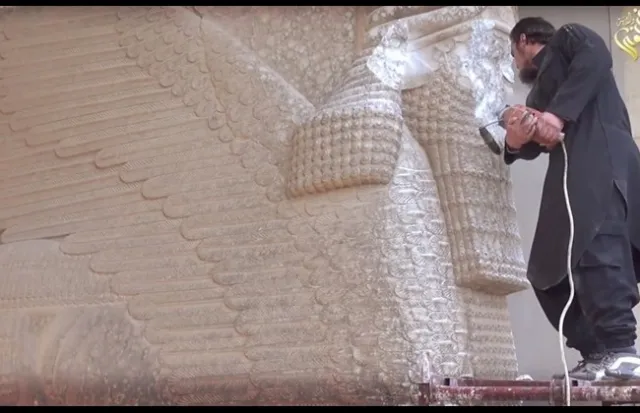ISIS Cultural Destruction: In Brief
May 5, 2015

By Mia Tomijima

War and political takeovers define history, but are also often responsible for erasing it. The devastating effects of these feuds result in the destruction of cities, people, and culture. Political leaders often make it a goal of destroying cultural heritage as a way of rewriting history and imparting their political, religious or ideological beliefs upon the civilization they are taking over. As the Nazis did during World War II, ISIS has emerged as the most recent group to destroy cultural heritage to further its ideology.
ISIS (or ISIL), shorthand for the Islamic State of Iraq and Syria, is a group of militants that have taken over parts of Iraq and Greater Syria (Syria, Lebanon, Turkey, and Jordan) and claim to represent Muslims worldwide. ISIS emerged during the summer of 2014, and quickly drew media attention with video recorded beheadings of journalists, and other reported massacres.
Alarming reports from the archaeological community show that ISIS militants are now attempting to impose their ideology by demolishing cultural sites in Northern Iraq, including the Mosul Museum, the ancient city of Hatra, and other Assyrian capitals. The systematic public destruction of cultural property politically motivated to attract media attention is also considered to be a war crime under the 1954 Hague Convention for the Protection of Cultural Property in the Event of Armed Conflict. In addition to the senseless destruction, ISIS is also selling Assyrian antiquities on the black market, using the proceeds to fund their campaign. Center for Art Law recently wrote on one such report of an Assyrian statue head emerging in the U.S., and the U.S. Attorney’s Office’s response to bring civil forfeiture proceedings on behalf of war-torn countries.
ISIS affiliation is even claiming responsibility over a recent attack in Texas, involving a shooting that occurred outside a cartoon contest of Prophet Mohammed in Texas (however no formal proof of affiliation of the shooters has yet to be shown). There has been great discussion in the archaeological, legal, and political communities over the destruction of cultural property in Iraq and Syria, including this Yale News conversation with Assyriology Professor Eckart Frahm, and this Democracy Now interview of Columbia University’s Near Eastern and East Mediterranean art and archaeology Professor Zainab Bahrani, who has consulted UNESCO on such matters.
On February 12, 2015, UN Security Council adopted Resolution 2199 to try to curb traffic in looted Syrian and Iraqi artifacts sold by ISIS members. In response to this call for action, French President François Hollande and members of the United States Congress recently issued statements in support of protecting cultural patrimony from the ISIS occupied territories. On April 26, 2015, the US House Committee on Foreign Affairs proposed a bill, H.R. 1493 Protect and Preserve International Cultural Property Act, which would, among other things, “require the Department of State to designate a department official to coordinate the efforts of the federal government to protect international cultural property… and develop strategies to reduce the illegal trade in such property and to assist countries in protecting their heritage sites and preventing looting and theft of cultural property.”
At an emergency meeting in July 2014, UNESCO’s Director General Irina Bokova stated “humanitarian and security concerns are inseparable from culture. Protecting the lives of people, their cultural heritage and identity go hand in hand,” and pledged that “UNESCO will continue mobilizing the United Nations Organization and the whole international community to safeguard Iraq’s cultural heritage with particular emphasis on the fight against illicit trafficking in cultural property.”
Sources:
- Ben Wedeman and Laura Smith-Spark, ISIS threatens Iraq’s Priceless Cultural Heritage, CNN (Oct. 23, 2014), http://www.cnn.com/2014/10/22/world/meast/iraq-isis-cultural-destruction/
- Susan Gonzalez, ISIS’ destruction of cultural antiquities: Q&A with Eckart Frahm, Yale News (Mar. 16, 2015), http://news.yale.edu/2015/03/16/isis-destruction-cultural-antiquities-qa-eckart-frahm
- Holly Yan, ISIS Claims Responsibility for Texas Shooting but Offers No Proof, CNN, May 5, 2015, http://www.cnn.com/2015/05/05/us/garland-texas-prophet-mohammed-contest-shooting/
- Security Council Approves Resolution Targeting Sources of Financing for ISIL, UN News Centre (Feb. 12, 2015), http://www.un.org/apps/news/story.asp?NewsID=50067#.VUkhOdozYy4
- UNESCO Office for Iraq, Emergency Response Plan to safeguard Iraqi Heritage (July 7, 2014), http://www.unesco.org/new/en/iraq-office/about-this-office/single-view/news/emergency_response_action_plan_to_safeguard_iraqi_heritage/#.VUkBGtozYy4
- Antiquities Scholar: Islamic State’s Destruction of Museum & Library is Cultural and Ethnic Cleansing (Feb. 27, 2015), http://www.democracynow.org/2015/2/27/antiquities_scholar_islamic_states_destruction_of
- “We Stand Together” to protect Iraq’s cultural heritage, says French President with UNESCO Director-General (Mar. 18, 2015), http://whc.unesco.org/en/news/1250
- Legislators Call for US Treasury Sanctions Against Dealers of Looted Syrian Antiquities (Mar. 31, 2015), http://rt.com/usa/245669-treasury-sanctions-syrian-artifacts/
*About the Author: Mia Tomijima is a recent graduate of Brooklyn Law School, where she received a certificate in intellectual property and served as Chair of the Art Law Association. She received a bachelor’s degree in art history from UCLA, and has worked with museums, auction houses, and law firms on both coasts. Mia is a post-graduate fellow with Center for Art Law.
Disclaimer: This article is for educational purposes only and is not meant to provide legal advice. Readers should not construe or rely on any comment or statement in this article as legal advice. For legal advice, readers should seek an attorney.




You must be logged in to post a comment.